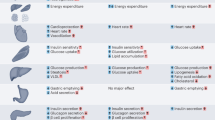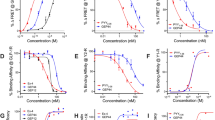Abstract
OBJECTIVE:
Compromise of gastric inhibitory polypeptide (GIP) receptor action and activation of cholecystokinin (CCK) receptors represent mechanistically different approaches to the possible treatment of obesity-related diabetes. In the present study, we have compared the individual and combined effects of (Pro3)GIP[mPEG] and (pGlu-Gln)-CCK-8 as an enzymatically stable GIP receptor antagonist and CCK receptor agonist molecule, respectively.
RESULTS:
Twice-daily injections of (pGlu-Gln)-CCK-8 alone and in combination with (Pro3)GIP[mPEG] in high-fat-fed mice for 34 days significantly decreased the energy intake throughout the entire study (P<0.05 to P<0.01). Body weights were significantly depressed (P<0.05 to P<0.01) in all treatment groups from day 18 onwards. Administration of (pGlu-Gln)-CCK-8, (Pro3)GIP[mPEG] or a combination of both peptides significantly (P<0.01 to P<0.001) decreased the overall glycaemic excursion in response to both oral and intraperitoneal glucose challenge when compared with the controls. Furthermore, oral glucose tolerance returned to lean control levels in all treatment groups. The beneficial effects on glucose homeostasis were not associated with altered insulin levels in any of the treatment groups. In keeping with this, the estimated insulin sensitivity was restored to control levels by twice-daily treatment with (pGlu-Gln)-CCK-8, (Pro3)GIP[mPEG] or a combination of both peptides. The blood lipid profile on day 34 was not significantly different between the high-fat controls and all treated mice.
CONCLUSION:
These studies highlight the potential of (pGlu-Gln)-CCK-8 and (Pro3)GIP[mPEG] in the treatment of obesity-related diabetes, but there was no evidence of a synergistic effect of the combined treatment.
This is a preview of subscription content, access via your institution
Access options
Subscribe to this journal
Receive 12 print issues and online access
$259.00 per year
only $21.58 per issue
Buy this article
- Purchase on Springer Link
- Instant access to full article PDF
Prices may be subject to local taxes which are calculated during checkout





Similar content being viewed by others
References
Gault VA, Flatt PR, O’Harte FP . Glucose-dependent insulinotropic polypeptide analogues and their therapeutic potential for the treatment of obesity-diabetes. Biochem Biophys Res Commun 2003; 308: 207–213.
Creutzfeldt W . The entero-insular axis in type 2 diabetes--incretins as therapeutic agents. Exp Clin Endocrinol Diabetes 2001; 109: S288–S303.
Irwin N, Flatt PR . Evidence for beneficial effects of compromised gastric inhibitory polypeptide action in obesity-related diabetes and possible therapeutic implications. Diabetologia 2009; 52: 1724–1731.
Yip RG, Boylan MO, Kieffer TJ, Wolfe MM . Functional GIP receptors are present on adipocytes. Endocrinology 1998; 139: 4004–4007.
Kim SJ, Nian C, McIntosh CH . GIP increases human adipocyte LPL expression through CREB and TORC2-mediated trans-activation of the LPL gene. J Lipid Res 2010; 51: 3145–3157.
Irwin N, Flatt PR . Therapeutic potential for GIP receptor agonists and antagonists. Best Pract Res Clin Endocrinol Metab 2009; 23: 499–512.
Miyawaki K, Yamada Y, Ban N, Ihara Y, Tsukiyama K, Zhou H et al. Inhibition of gastric inhibitory polypeptide signaling prevents obesity. Nat Med 2002; 8: 738–742.
Gault VA, O’Harte FP, Harriott P, Flatt PR . Characterization of the cellular and metabolic effects of a novel enzyme-resistant antagonist of glucose-dependent insulinotropic polypeptide. Biochem Biophys Res Commun 2002; 290: 1420–1426.
Woods SC, West DB, Stein LJ, McKay LD, Lotter EC, Porte SG et al. Peptides and the control of meal size. Diabetologia 1981; 20: S305–S313.
Isken F, Pfeiffer AF, Nogueiras R, Osterhoff MA, Ristow M, Thorens B et al. Deficiency of glucose-dependent insulinotropic polypeptide receptor prevents ovariectomy-induced obesity in mice. Am J Physiol Endocrinol Metab 2008; 295: E350–E355.
Hansotia T, Maida A, Flock G, Yamada Y, Tsukiyama K, Seino Y et al. Extrapancreatic incretin receptors modulate glucose homeostasis, body weight, and energy expenditure. J Clin Invest 2007; 117: 143–152.
Ding KH, Zhong Q, Xie D, Chen HX, Della-Fera MA, Bollag RJ et al. Effects of glucose-dependent insulinotropic peptide on behavior. Peptides 2006; 27: 2750–2755.
Fulurija A, Lutz TA, Sladko K, Osto M, Wielinga PY, Bachmann MF et al. Vaccination against GIP for the treatment of obesity. PLoS One 2008; 3: e3163.
Montgomery IA, Irwin N, Flatt PR . Active immunization against (Pro3)GIP improves metabolic status in high-fat-fed mice. Diabetes Obes Metab 2010; 12: 744–751.
Irwin N, Hunter K, Flatt PR . Comparison of the metabolic effects of GIP receptor antagonism and PYY(3-36) receptor activation in high fat fed mice. Peptides 2007; 28: 2192–2198.
Irwin N, Hunter K, Flatt PR . Comparison of independent and combined chronic metabolic effects of GIP and CB1 receptor blockade in high-fat fed mice. Peptides 2008; 29: 1036–1041.
Irwin N, Hunter K, Frizzell N, Flatt PR . Antidiabetic effects of sub-chronic administration of the cannabinoid receptor (CB1) antagonist, AM251, in obese diabetic (ob/ob) mice. Eur J Pharmacol 2008; 581: 226–233.
Lee HK, Choi EB, Pak CS . The current status and future perspectives of studies of cannabinoid receptor 1 antagonists as anti-obesity agents. Curr Top Med Chem 2009; 9: 482–503.
Ivy AC, Oldberg E . A hormone mechanism for gallbladder contraction and evacuation. Am J Physiol 1928; 65: 599–613.
Verbaeys I, León-Tamariz F, Buyse J, De Cuyper M, Pottel H, Van Boven M et al. PEGylated cholecystokinin prolongs satiation in rats: dose dependency and receptor involvement. Br J Pharmacol 2007; 152: 396–403.
Cantor P, Rehfeld JF . Cholecystokinin in pig plasma: release of components devoid of a bioactive COOH-terminus. Am J Physiol 1989; 256: G53–G61.
Rehfeld JF, Friis-Hansen L, Goetze JP, Hansen TV . The biology of cholecystokinin and gastrin peptides. Curr Top Med Chem 2007; 7: 1154–1165.
O'Harte FP, Mooney MH, Kelly CM, Flatt PR . Glycated cholecystokinin-8 has an enhanced satiating activity and is protected against enzymatic degradation. Diabetes 1998; 47: 1619–1624.
Irwin N, Frizelle P, Montgomery IA, Moffett RC, O’Harte FPM, Flatt PR . Beneficial effects of the novel choleycystokinin agonist (pGlu-Gln)-CCK-8 in animal models of obesity-diabetes. Diabetologia 2012; 55: 2747–2758.
McClean PL, Irwin N, Hunter K, Gault VA, Flatt PR . (Pro(3))GIP[mPEG]: novel, long-acting, mPEGylated antagonist of gastric inhibitory polypeptide for obesity-diabetes (diabesity) therapy. Br J Pharmacol 2008; 155: 690–701.
Kerr BD, Irwin N, O’Harte FP, Bailey CJ, Flatt PR, Gault VA . Fatty acid derivatised analogues of glucose-dependent insulinotropic polypeptide with improved antihyperglycaemic and insulinotropic properties. Biochem Pharmacol 2009; 78: 1008–1016.
Flatt PR, Bailey CJ . Abnormal plasma glucose and insulin responses in heterozygous lean (ob/+) mice. Diabetologia 1981; 20: 573–577.
Weickert MO, Möhlig M, Spranger J, Schöfl C, Loeffelholz CV, Riepl RL et al. Effects of euglycemic hyperinsulinemia and lipid infusion on circulating cholecystokinin. J Clin Endocrinol Metab 2008; 93: 2328–2333.
Rehfeld JF . Incretin physiology beyond glucagon-like peptide 1 and glucose-dependent insulinotropic polypeptide: cholecystokinin and gastrin peptides. Acta Physiol (Oxf) 2011; 201: 405–411.
Eckel RH, Fujimoto WY, Brunzell JD . Gastric inhibitory polypeptide enhanced lipoprotein lipase activity in cultured preadipocytes. Diabetes 1979; 28: 1141–1142.
Zhou H, Yamada Y, Tsukiyama K, Miyawaki K, Hosokawa M, Nagashima K et al. Gastric inhibitory polypeptide modulates adiposity and fat oxidation under diminished insulin action. Biochem Biophys Res Commun 2005; 335: 937–942.
Ahrén B, Pettersson M, Uvnäs-Moberg K, Gutniak M, Efendic S . Effects of cholecystokinin (CCK)-8, CCK-33, and gastric inhibitory polypeptide (GIP) on basal and meal-stimulated pancreatic hormone secretion in man. Diabetes Res Clin Pract 1991; 13: 153–161.
Lo CM, Obici S, Dong HH, Haas M, Lou D, Kim DH et al. Impaired insulin secretion and enhanced insulin sensitivity in cholecystokinin-deficient mice. Diabetes 2011; 60: 2000–2007.
Marks V . The metabolic syndrome. Nurs Stand 2003; 17: 37–44.
Acknowledgements
These studies were supported by the SAAD Trading and Contracting Company and the Department of Education and Learning, Northern Ireland.
Author information
Authors and Affiliations
Corresponding author
Ethics declarations
Competing interests
NI, FPMO’H and PRF hold shares in Diabetica Ltd, which has patents for the exploitation of peptide therapeutics.
Rights and permissions
About this article
Cite this article
Irwin, N., Montgomery, I., O'Harte, F. et al. Comparison of the independent and combined metabolic effects of subchronic modulation of CCK and GIP receptor action in obesity-related diabetes. Int J Obes 37, 1058–1063 (2013). https://doi.org/10.1038/ijo.2012.179
Received:
Revised:
Accepted:
Published:
Issue Date:
DOI: https://doi.org/10.1038/ijo.2012.179



